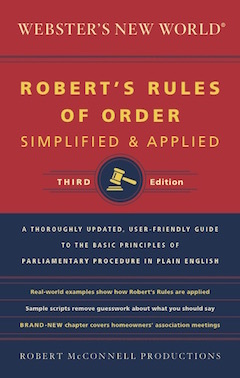Rules of Order as one governing document of an organization
Volume 6, Issue 2, February, 2000
drvideo@comcast.net
In the previous newsletter we wrote about the Corporate Charter. In this newsletter we will explain what "rules of order" are and where they should be placed in the series of an organization's governing documents.
RULES OF ORDER
These are rules that refer to parliamentary procedure that are adopted by the organization. After an organization has adopted a parliamentary authority it may want to do some things different than the authority. So they adopt rules of order. These rules relate to the orderly transaction of business and to the duties of officers in connection with conducting the business. For example, it may want to have a different order of business than the authority recommends or different limits on debate.
Different order of business. Some organizations may have a different order of business than what is commonly practiced. Since these are different than the adopted parliamentary authority, they would be placed in "rules of order". For example, an organization may have long involved ceremonies that must be performed in a certain order. Or it may have a different order of business for its different types of meetings. Or they may have election rules that are unique to it. Anything of this nature that is different from the adopted parliamentary authority should be placed in the document called rules of order.
However, an organization should not re-invent the wheel and include in this document such things as how to make a motion, how to preside, or other common parliamentary rules that can be found in a parliamentary authority. By adopting a parliamentary authority, the members are adopting sufficient rules of meeting procedures to help them solve their meeting problems. Rules of order are adopted when an organization wants to do something different than the parliamentary authority. However, whatever the organization adopts should conform to common parliamentary law.
Some city governments that the author is familiar with have adopted such rules of order that concern different motions. One such rule that this author has heard about is concerning the motion to "reconsider the vote". Robert's Rules states that this motion can only be made at the meeting the motion was voted on and by the prevailing side. However, some cities have adopted rules that allow the motion to be reconsidered at the next regular meeting. Others may allow anyone to make the motion to reconsider the vote. It depends on how the organization views this motion.
Rules of Order are mistakenly included in bylaws. The proper way to handle rules of order is to have them as a separate document, with its own heading but included in the same booklet as the bylaws.
Rules of order usually provide for their suspension at a meeting. However, according to parliamentary practice they can be suspended by a two thirds vote "except in the case of a rule protecting a minority of less than one third of those voting." (ROBERT'S RULES OF ORDER NEWLY REVISED, p. 17) The book also states on page 262, under the motion "to suspend the rules", that any rule protecting the right of absent members or a basic right of an individual member can't be suspended. The book then gives the examples of :
1. previous notice can not be suspended because it protects the absent members
2. if the bylaws provide for a secret ballot for officers or other actions. For one member to object would have him exposing his vote.
If an organization puts any rules of order in the bylaws, then the members need to know that any parliamentary rules in the bylaws can be suspended. However, the other bylaws having to do with the structure of the organization can't be suspended unless this is provided for in the bylaws.
AMENDING RULES OF ORDER. Rules of order that are separate from the bylaws are adopted and amended by previous notice and a two thirds vote. If no notice is given, then they can be adopted by the vote of the majority of the entire membership of the organization.
To adopt rules of order that are placed within the bylaws, the organization must follow its rules for amending the bylaws.
